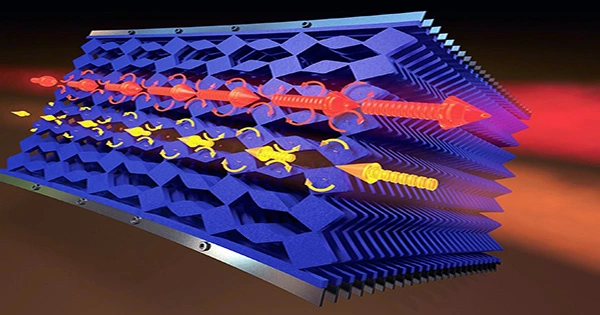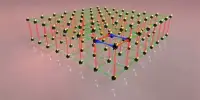Complex artificial structures called mechanical metamaterials have mechanical properties that are determined by their structure rather than their content. Although the development of new technology has shown these structures to be very promising, designing them can be difficult and time-consuming.
Convolutional neural networks (CNNs), a family of machine learning algorithms, have recently been shown to have the potential for building intricate mechanical metamaterials by researchers from the University of Amsterdam, AMOLF, and Utrecht University. Their article, which was released in Physical Review Letters, proposes two distinct CNN-based techniques that can identify and capture the fine-grained combinatorial principles underlying the development of mechanical metamaterials.
According to Ryan van Mastrigt, one of the study’s authors, “our current study can be considered a continuation of the combinatorial design approach outlined in a prior paper, which can be applied to more intricate building blocks.” “Aleksi Bossart and David Dykstra were working on a combinatorial metamaterial that is able to host many functions, meaning a material that can deform in numerous distinct ways depending on how one actuates it, around the time I started working on this project.
Van Mastrigt and his associates attempted to isolate the principles governing the effective creation of complicated metamaterials as part of their earlier research. As the “building blocks” that make up these structures can be distorted and placed in an almost infinite number of different ways, they rapidly recognized that this was by no means an easy undertaking.
Previous research demonstrated that it is possible to simulate every potential configuration and deformation of metamaterials when their unit cell sizes are tiny (i.e., when there are few “building blocks” available). But when these unit cell sizes increase, the work becomes either impossible or very difficult.
Van Mastrigt said, “We decided to examine machine learning as a serious alternative since we were unable to reason about any fundamental design rules and conventional methods failed to allow us to explore larger unit cell designs in an effective way. “Finding a machine learning tool that would enable us to explore the design space much more quickly became the main goal of our work as a result. With our findings, I believe we were successful and even surpassed our own goals.”
Van Mastrigt and his colleagues first had to overcome a number of obstacles in order to successfully train CNNs to handle the design of complicated metamaterials. They had to figure out how to accurately depict their metamaterial designs first.
Van Mastrigt stated, “We tested a few ways and ultimately decided on what we refer to as the pixel representation. “This representation encodes the orientation of each construction block in a straightforward visual manner, casting the classification problem to a visual pattern recognition problem, which is exactly what CNNs are good at,” the author writes.
The researchers then had to come up with strategies that took into account the enormous class imbalance in metamaterials. To put it another way, training CNNs to infer combinatorial rules for the various classes can entail different processes because there are now more known metamaterials belonging to class I than class C, which is the class that the researchers are interested in.
Van Mastrigt and his associates developed two distinct CNN-based methods to address this problem. These two methods can be used to solve categorization issues for various metamaterial types.
Van Mastrigt stated, “In the instance of metamaterial M2, we aimed to develop a training set that is class-balanced. “We accomplished this via naive undersampling (i.e., discarding a large number of class I samples) and combine this with symmetries, such as translational and rotational symmetry, which we know some designs have, to construct more class C designs.
“Therefore, this technique necessitates some domain expertise. The crucial notion is that this reweighting of class C cancels out with the far greater number of class I designs in the training set. In contrast, for metamaterial M1, we added a reweight term to the loss function such that the uncommon class C designs weigh more heavily during training. There is no domain expertise needed for this strategy.
Both of these CNN-based techniques for determining the combinatorial principles underlying the creation of mechanical metamaterials showed extremely encouraging results in preliminary tests. The researchers discovered that based on the baseline dataset utilized and known (or unknown) design symmetries, they each performed better on different tasks.
“We showed just how extraordinarily good these networks are at solving complex combinatorial problems,” van Mastrigt said. “This was really surprising for us, since all other conventional (statistical) tools we as physicists commonly use fail for these types of problems. We showed that neural networks really do more than just interpolate the design space based on the examples you give them, as they appear to be somehow biased to find a structure (which comes from rules) in this design space that generalizes extremely well.”
These researchers’ most recent discoveries may have profound effects on how metamaterials are created. The networks they trained have been used so far to build a few metamaterial structures, but they might also be utilized in the future to build much more intricate designs that would be very challenging to implement using traditional physics modeling tools.
The research by van Mastrigt and his colleagues also demonstrates the enormous value of CNNs for dealing with combinatorial problems, which are optimization tasks that require creating a “optimal object” or arriving at an “optimal solution” that satisfies all constraints in a set, in situations where there are many variables at play. This article could encourage the usage of CNNs in different research and development environments as combinatorial challenges are prevalent in many scientific domains.
The researchers demonstrated that machine learning can still be very helpful for exploring the design space for metamaterials, as well as perhaps other materials, objects, or chemical substances, even though it is typically a “black box” approach and does not always allow researchers to view the processes behind a given prediction or outcome. This might thus make it easier to analyze and comprehend the intricate laws that underlie successful designs.
Van Mastrigt continued, “In our subsequent studies, we will focus on inverse design. “The existing tool already greatly aids us in reducing the design space to locate suitable (class C) designs, but it fails to provide us with the optimal design for the task we have in mind. We are now researching machine learning techniques that will enable us to locate exceedingly unusual designs with the desired attributes, ideally even when the machine learning technique has never seen examples of such designs before.
Because of our recent research, we are optimistic that neural networks will help us solve this challenging problem.
















